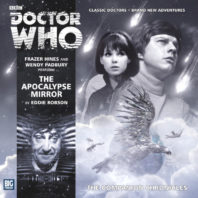
Released May 2013
Landing in the devastated city of Tromesis on an Earth that is far from familiar in Eddie Robons’s ‘The Apocalypse Mirror,’ the Doctor, Jamie, and Zoe learn of a ghostly mirror image of the city that appears as it existed before disaster struck. As people fall ill and vanish with fearsome metal birds attacking from the sky, the very notion of a future is anything but guaranteed.
‘The Apocalypse Mirror’ taps into a more surreal and visual type of fiction than Doctor Who often explores, and the remaining citizens being carried off one by one by predatory creatures lends an immediacy to the threat that the so-called nostalgia sickness that causes those afflicted to see the earlier version of the city more lyrically introduces. With a meteorite likewise approaching the city and those who would have been able to help already missing, the layers of the story all intersect well and help to reinforce certain staples of the franchise while completely subverting others. Indeed, as is completely logical for a civilisation facing impending disaster, every action of the Doctor and his companions is questioned, and trust is the most difficult commodity to come by in these times.
Yet as the people try to avoid thinking about those who have become ill in an attempt to avoid contracting the disease while also running from the government that is oppressing them so wholly, the Doctor discovers that the government has actually been working in its peoples’ best interest, trying to help them move to the better version of the city that is still so filled with hope. Unfortunately, the logic behind the existence of this mirror city is somewhat tenuous and explained fairly cavalierly as being the result of a so-called sympathy engine that drew upon the hope of the people in the ruined city. While this by itself is still an intriguing enough foundation, it does mean that the resolution is likewise tied to simply getting the people facing destruction to believe that a better hope exists and to forget the dark truth of their surroundings. This does add to the fairy tale quality of the story, but using it as the foundation for a resolution with results that remain ambiguous and undetailed is underwhelming and less steeped in logic and a true semblance of realism than stories looking to deliver more profound consequences.
Strangely, despite Wendy Padbury being present to voice Zoe, Zoe is hardly present in the story at all, meaning that Frazer Hines more or less provides all of the voices for the fairly large ensemble of characters. Hines has, of course, proven himself incredibly adept at doing so before and acquits himself quite well here, but having a second voice for him to play off throughout could have further enhanced the natural progression of scenes and conversations without losing any of Hines’s power as both Jamie and the Doctor. Still, all of the leads come to life spectacularly and realistically, and the typical strong direction and sound design help to ensure that the unsettling atmosphere and pervasive threat of decay and danger always remain present in an otherwise uneven story to spur the Doctor and Jamie on while ensuring attention is paid to the details until the very end.
- Release Date: 4/2013


Leave a Reply